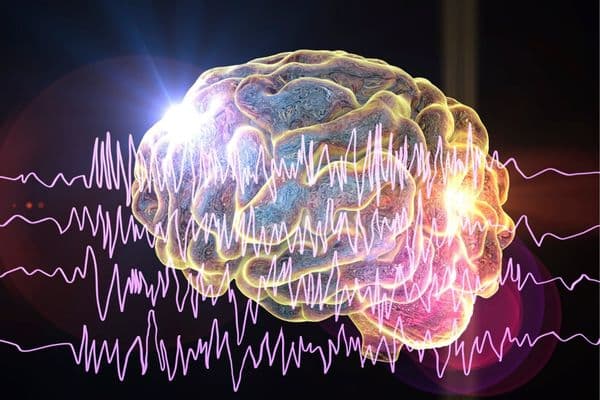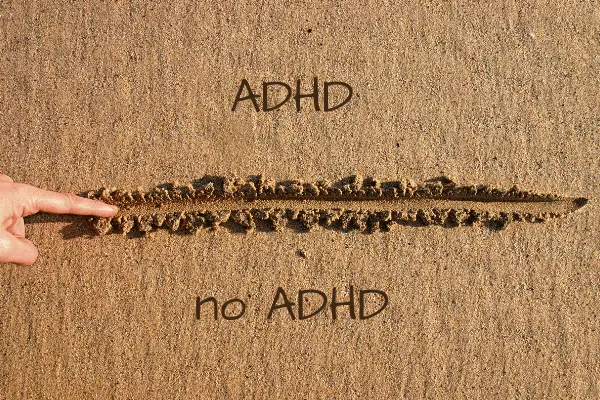Ring of Fire ADHD is the most severe of Dr. Amen’s 7 Types of ADHD.
What is Ring of Fire ADHD?
Ring of Fire ADHD is the most severe of the 7 types of ADHD according to Dr. Amen. Dr. Amen says that people with Ring of Fire ADHD have an overall hyperactive brain activity.

When seen on a SPECT scan, Dr. Amen describes this type of ADHD as a ring of hyperactivity around the brain, leading to the name “Ring of Fire.”
Within Dr. Amen’s concept of 7 types of ADHD, this is considered the most intense form of ADHD, and people with Ring of Fire ADHD have very severe symptoms.

It is important to note that Dr. Amen’s classification system for ADHD and his use of SPECT scans are not accepted by the medical establishment. So Ring of Fire ADHD and Dr. Amen’s 7 Types of ADHD are very different from the accepted DSM criteria for diagnosis of ADHD.
The medical establishment’s understanding of ADHD is that is a neurodevelopmental condition and is classified into 3 types: hyperactive, inattentive and combined.
Ring of Fire ADHD Symptoms
The Amen Clinic says that in addition to ADHD core symptoms, Ring of Fire ADHD symptoms include:
- Irritability
- Impulsivity
- Sensitive to noise, light, clothes or touch
- Periods of mean, nasty or insensitive behavior
- Grandiose or inflexible thinking
- Talking fast
- Racing thoughts
- Appears anxious or fearful
- May or may not be hyperactive

What Ring of Fire ADHD Symptoms Look Like
With Ring of Fire ADHD there is hyperactive brain activity that is believed to be what leads to having difficulty remaining focused on tasks. This can cause serious problems at home, work or school.
The emotional dysregulation of Ring of Fire ADHD is severe, and causes a great deal of problems.(Emotional dysregulation is a symptom that is widely recognized to be part of ADHD but ignored by the DSM criteria)
This can present as having low frustration tolerance and a quick temper. A person with Ring of Fire ADHD might easily yell at someone, be highly reactive and have emotional outbursts that seem to be ‘too much’.

Anxiety is heightened, ruminating, excessive worrying and obsessiveness may be seen.
There may be a feeling of a racing mind, being overwhelmed with thoughts, and difficulty in turning off the brain.
There can be a hypersensitivity to the environment, an intolerance to bright lights and noise, as is seen with concussions.

Ring of Fire ADHD and Inflammation
Dr. Amen says that Ring of Fire ADHD is linked to allergy, infection, or inflammation in the brain.
Inflammation in the brain that does not cause critical illness is an idea not readily recognized by the medical establishment. So it’s possible that this is a way that brain inflammation presents.
This means adult onset Ring of Fire ADHD could be considered an acquired neurodiversity rather than a neurodevelopmental condition which is how the DSM defines ADHD.

Meaning the adult ADHD symptoms could be caused by inflammation in your brain. Although it could also be that a mild form of ADHD could be worsened and become Ring of Fire ADHD with inflammation.
With the medical model of ADHD it is considered neurodevelopmental, a condition you have from birth. However most experts in ADHD understand that life stressors can make the symptoms of ADHD more severe. And there is recent research which is looking at classifying ADHD based on age
Studies Linking Inflammation to ADHD
In this study looking at neuroinflammation and ADHD they listed 5 reasons that inflammation could be linked to ADHD.
- above chance comorbidity of ADHD with inflammatory and autoimmune disorders
- studies indicating an association with ADHD and increased serum cytokines
- genetic studies showing associations between inflammatory pathway genes and ADHD
- evidence that early life exposure to risk factors may increase risk for ADHD via an inflammatory mechanism
- evidence from animal models that maternal immune activation can lead to ADHD

Proposed ways that inflammation can cause ADHD are glial activation, neuronal damage and degeneration, increased oxidative stress, reduced neurotrophic support, altered neurotransmitter metabolism, and blood-brain barrier disruption.
There is an idea that mast cell activation may be involved in the occurrence and development of ADHD, but there is currently insufficient evidence to support this theory. Mast cells may cause or aggravate neuroinflammation, releasing inflammatory factors, interacting with glial cells and neurons, and disrupting the blood-brain barrier integrity.
Tests for Ring of Fire ADHD
Dr. Amen uses SPECT studies to classify ADHD into 7 Types. SPECT scans are expensive, expose you to radiation and the use for ADHD is controversial.
It would be helpful if there was a cheaper way to test for ADHD. Many studies have looked at options for a screening test for ADHD, but nothing reliable has been found.
When thinking about a test for ADHD it is important to understand that there is actually no stable, agreed upon, and biologically valid concept of any psychiatric disorder. Which makes the The Diagnostic and Statistical Manual of Mental Disorders (DSM) classification of mental conditions a poor basis for biological and genetic research.
Considering that Dr. Amen’s Ring of Fire ADHD is felt to be linked inflammation or infection, the results of a systematic review on potential biomarkers in adults with ADHD is very interesting.
The systematic review reported that lower salivary cortisol levels predicted both symptom severity and response to ADHD medications in Adults with ADHD.

Cortisol is a hormone involved in the stress response. This would suggest that inflammation does have a role in ADHD severity in adults with ADHD.
We are currently in a pandemic with a virus known to invade the brain, and cause symptoms described as ‘brain fog’ and other neuropsychiatric issues. It will be interesting to see how we progress in understanding how infection and inflammation in the brain can cause symptoms and how we can treat it.
Treatment of Ring of Fire ADHD
Dr. Amen believes that Ring of Fire ADHD is made worse with stimulants and medication that increase serotonin.
Rather he looks to increase GABA and serotonin through supplements like L-tyrosine , 5-HTP and GABA, and also look to eliminate trigger foods, to treat Ring of Fire ADHD.
They also consider the use of medications such as anticonvulsants as well as the non-stimulant ADHD medications guanfacine or clonidine.
Guanfacine and clonidine work by activating α2A adrenoceptors within the central nervous system. Basically they calm the sympathetic nervous system.
There is also evidence they work in the prefrontal cortex to improve cognition. (A major issue with ADHD is poor working memory – also called ADHD ‘object permanence’ issues)

Supplements are not regulated the same way as medications so it is important to take good quality supplements. The Huberman Lab has partnered with Momentous to provide best-in-class human performance supplements that meet Dr. Huberman’s quality standards.
Here are some specific The Huberman Lab designed bundles:
Huberman Lab Focus & Cognition Bundle
Huberman Lab Complete Product Bundle
You can use the code VASTMIND to get a discount of 15% off your order at Momentous.
References
- Dr. Amen – Healing ADD book
- Neuroinflammation as a risk factor for attention deficit hyperactivity disorder
- Mast cell-mediated neuroinflammation may have a role in attention deficit hyperactivity disorder (Review)
- A Review on the Role of Inflammation in Attention-Deficit/Hyperactivity Disorder
- Biomarkers and Attention-Deficit/Hyperactivity Disorder: A Systematic Review and Meta-Analyses
- Role of Oxidative Stress and Neuroinflammation in Attention-Deficit/Hyperactivity Disorder
- Toward Precision Medicine in ADHD